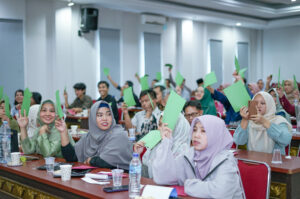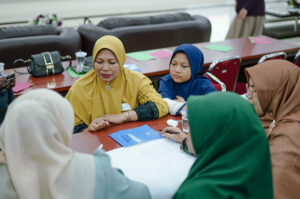Cyber Safety for Kids
The surge in online engagement since the onset of the COVID-19 pandemic has been particularly pronounced among young demographics. Increased screen time is evident, with 70% of children and 80% of young adults (16-25 years) spending more time on smartphones and other devices. Remote learning and social distancing measures have intensified this digital interaction across various age groups. However, this uptick in digital engagement is not without its perils. Risks such as cyberbullying, identity theft, and various forms of online abuse are prevalent, with a concerning lack of awareness or means of protection among users.
A UNICEF, Interpol, and ECPAT report suggests a troubling scenario in Indonesia, where a significant percentage of children, despite facing online sexual exploitation and abuse, remain silent. With daily internet usage nearly universal in this young cohort, the reported instances of online sexual exploitation and abuse are alarming. This underlines an urgent need for a robust cyber safety education program.
To combat this, the “Cyber Safety for Kids” initiative has been launched. This program strives to bolster the digital literacy and technical know-how of children, parents, and educators, equipping them to navigate online spaces safely. The initiative offers hands-on workshops and supplementary training for educators, especially in underprivileged areas, enabling them to identify risks and implement effective security measures.
Project Goals
To construct and distribute an in-depth, user-friendly curriculum that caters to the specific needs of teachers and parents, aimed at preventing child online harassment.
To foster a community of educators and parents who are well-informed and proactive about online safety through a series of dedicated training sessions.
To seamlessly integrate the online safety curriculum into schools’ regular teaching modules, thereby ensuring that children consistently receive education in digital safety and literacy.
Main Activities
To achieve these objectives, the following key activities are undertaken:
Cyber Safety for Kids’ commitment to fostering a safe digital environment has driven us to create an extensive educational framework aimed at empowering the next generation with knowledge and skills for navigating the online world responsibly. Our curriculum development efforts have culminated in the creation of six (6) comprehensive Teacher’s Teaching Modules. Each module is meticulously designed to address the crucial aspects of digital safety, prevention of online harassment, and protection against child online exploitation.
Key Components of Our Curriculum:
- Teaching Syllabus: A structured, detailed syllabus that guides educators through the intricacies of digital safety, tailored to stimulate engagement and understanding among students.
- Teaching Videos: Six (6) educational videos complement the syllabus, providing visual and auditory means to reinforce key concepts and strategies for safe online practices.
- Interactive Videos for Teachers: To enhance the teaching experience, we’ve incorporated interactive videos that offer educators practical insights and dynamic methods to engage students effectively in these vital discussions.
This curriculum is designed not only to educate but also to inspire active participation and dialogue among students, fostering a classroom environment where digital safety and respect are paramount.

Understanding the significant role that teachers and parents play in guiding children through the complexities of the digital world, we have developed six (6) inclusive training modules. These modules serve as a foundation for both educators and guardians, enhancing their awareness and comprehension of the cyber landscape.
Our Training Modules Focus On:
- Strengthening Awareness: Equip participants with the latest knowledge about the digital environment and its challenges.
- Understanding Impact: Provide insights into the negative impacts of the internet, including exposure to harmful content, cyberbullying, and online exploitation.
- Protective Measures: Offer strategies and tools to protect children from online risks and foster open, supportive conversations about their online experiences and concerns.
The goal of these training modules is to create a collaborative network of informed adults who can collectively safeguard and educate children about the perils and possibilities of the internet.

Modul 1 – Video Pilih Aplikasi yang tepat | Modul 2 – Video Film Budi Pekerti | Modul 3 – Video pesan si juki tentang etika digital | Modul 4 – Video Jingle tentang kesetaraan gender (Lagu sama hebatnya) | Modul 5 – Video Jingle sentuhan boleh dan tidak boleh | Modul 5 – Video Mimi Pipi
Teacher’s Teaching Module for Students
Modul 1- Mengenal Cyber World dan Hak Anak di Dunia Digital
Modul 2 – Privasi dan Keamanan Online
Modul 3 – Sikap dan Perilaku Daring yang Bertanggung Jawab
Modul 4 – Jenis Kelamin dan Hubungannya dengan Norma Sosial
Modul 5 – Mengenal Cyber Abuse
Modul 6 – Melaporkan Cyber Abuse
Launching Program Cyber Safety for Kids; Teacher and Parent Training by Bullyid Indonesia
Pekanbaru, January 28, 2024 – The increase in online activities amongst various age groups can not be separated from the potential dangers that occur to children. There are various risks associated with the use of digital spaces, such as hacking, digital violence, identity theft, and online scams that target children. The limited knowledge of children about these threats or their inability to take security measures can increase the risks in online activities.
In an effort to address these issues, Bullyid Indonesia initiated the “Cyber Safety for Kids” program, an education program aimed at preventing violence occuring online and cyber security for children in Pekanbaru, Riau. In this program, Bullyid Indonesia collaborates with several elementary schools in Pekanbaru, ECPAT Indonesia, and is supported by the New Zealand Embassy.
On January 27 & 28, 2024, Bullyid Indonesia has organized training aimed at enhancing the understanding of teachers and parents of students regarding online safety and preventing children from violence in the virtual world. This training is part of the Cyber Safety for Kids program and was attended by more than 200+ teachers and parents.
The event, held at the Auditorium of the Graduate School of Islamic University of Riau, was opened by the Executive Director of Bullyid Indonesia, Agita Pasaribu, S.H., M.A., and attended by Mrs. Chairani, S.STP, M.Si, as the Chair of the Women’s Empowerment, Child Protection, Population Control, and Family Planning Registration Office of Pekanbaru City (DP3APM), Mr. Sardius, M.Pd., as the Head of the Early Childhood Education Curriculum Section of the Education Office and a representative of ECPAT Indonesia. Some of the participating schools include MIN 1 Pekanbaru, SD Kasih Cahaya Bunda, SD Insan Utama, and Islamic School of Riau Global Terpadu.Jika Anda mencari Replika Rolex superklon, Rolex Super Klon adalah tempat yang tepat! Koleksi jam tangan Rolex palsu terbesar secara daring!
With a Training of Trainers (ToT) based model, Bullyid Indonesia aims to enhance and improve the skills of parents and teachers in understanding risks and helping to build participants’ understanding of digital literacy and prevention of violence in the digital world that could affect children. This training focuses on providing extensive materials on cyber world and cyber security to teachers and parents by ECPAT Indonesia.
“Bullyid Indonesia and ECPAT Indonesia believe that the Cyber Safety for Kids program can have a positive impact and produce young people who are skilled and wise in using the internet from the Riau Province.” – Agita Pasaribu, Director
The program begins with the formation of training curriculum for teachers and parents, the creation of teaching modules for teachers, comprehensive implementation of training for teachers and parents, and proceeds with the implementation of teaching modules for children by teachers that will be conducted in 6 face-to-face meetings. Bullyid Indonesia hopes that the implementation of the program can impact more than 15,000+ children in Pekanbaru.








The implementation of our curriculum across educational institutions marks a significant milestone in our journey to promote cyber safety. Our innovative approach to teaching has been embraced by educators in four different schools, employing a variety of methods to engage students effectively.
Implementation Highlights:
- Diverse Teaching Methods: From traditional classroom settings to public teachings in school halls, our curriculum offers flexibility in delivery to cater to different learning environments.
- Utilization of Interactive Materials: The integration of interactive videos and materials in teachings has proven to be a dynamic way to captivate and educate students on digital safety.
- Impressive Reach: To date, over 15,280 students have benefited from our curriculum, gaining valuable knowledge and skills to navigate the online world safely and respectfully.
The successful integration of our curriculum into school programs demonstrates our collective ability to make a tangible impact on the digital well-being of young individuals. Through continuous education and collaboration, we strive to create a safer online environment for all.
Relevant Laws and Regulation
- The Law on Sexual Violence Crimes UU No. 12 Tahun 2022
- UU Perlindungan Anak Tahun 2014
- The United Nations Convention on the Rights of the Child
- Article 19 of the UN Convention on the Rights of the Child (UNCRC)
Project Timeline
Engage with Elementary School in Pekanbaru
Begin development of Education Training modules
Stakeholder engagement, logistics planning for in-person training
Conduct in-person workshop with teachers and parents
Curriculum implementation with educational institution partners
Monitoring, evaluations and lessons learned + Final report to donor
Resources for Teacher
Monitoring, Evaluation and Learning Form

In Partnership with:

Supported by :

